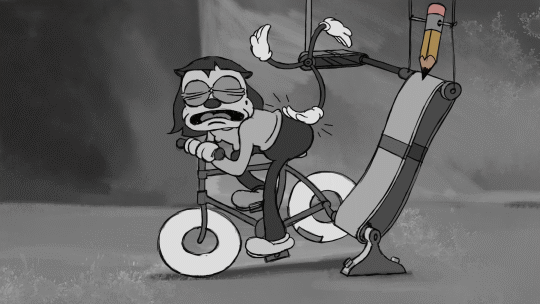mari jaye’s teaching statement

Tell your own story, and you will be interesting.
-Louise Bourgeois
As a teacher of storytelling and animation, I maintain that self-responsibility—owning one’s narrative— is integral to the learning process. When students can own their stories, as well as their mistakes, disorientation, and apparent dead ends, they are often on the soundest path to creativity. This applies not only to how I want my students to learn, but also to how I approach my own role. In an industry that requires discipline and manual labor, I aim to instill in my students the ability to work thoughtfully, purposefully, and fearlessly, never resorting to an assembly-line mentality. I want each individual to be well versed in the fundamental principles of animation, and to then discover for themselves the countless ways in which those principles can be applied and expanded upon. I encourage them to get themselves into trouble and to then draw on what we’ve learned in the classroom to generate solutions.
Anything is possible in animation, but it can be an exacting medium. There are definitive elements that must be in place for things to work. As it takes a lifetime to explore the nuances of movement, I focus on embodying a particular concept, not rote memorization. I have students observe and act out movements before I show them the “rules” for how they’re drawn. I believe that after struggling with a principle they will not only better understand the conventional solution, but will also see the strengths and weaknesses of their own attempts. This ensures that they are never simply mimicking, but rather making conscious choices based on the tools and lessons they’ve been given, and on their own unique mind at play. I encourage them to not fear mistakes and to trust that failed attempts can often be just as beneficial as successful ones (and that one often leads to the other). Being active agents in their own learning solidifies otherwise abstract concepts, and I continually seek ways to support it. My recent PLIG grant will make possible a reference library of student-generated slow-motion movements that other students will be able to access for years to come.
While my assignments value flexibility of approach, I believe that clear deadlines and objectives are an important part of education, especially within the context of the animation industry. Exposing students to this side of our practice is the reason I created the SOFA New York City Trip, where they hear from producers and directors and professionals alike that what we do in the classroom is not happening in a bubble. I consistently provide students with a set of parameters and checkpoints which allow them to simultaneously gauge their progress, observe each other’s solutions, and, most importantly, understand the endless ways a given problem can be solved. Peer review occurs verbally in person or written through shared, live-updated Google documents. At the beginning of a class critique, I often hear them say something like, “I didn’t know if I could get it to work, but I did!” Within the structure of the classroom’s objectives, it’s vital that they’re able to claim ownership of their accomplishments.
My involvement in projects like NarRITives (a grant-funded collaboration between RIT’s Museum Studies, Journalism and Film programs), Mayor Warren’s What’s Good Rochester? (a city initiative to highlight residents through City Hall’s media platforms), and the Balkan Animated Storytelling Exploration (BASECamp) course is a testament to how important storytelling is to me. I model for my students these ways of engaging with stories, and encourage them at all turns to speak with their own voice while providing opportunites for others to do the same. I speak openly and candidly about perspective to dispel the idea that there is a default narrative.
I consider animation to be nothing short of magic, and as a teacher of animation I have a front row seat to this incredible show. I work to ensure that my students understand the tools and tricks of this craft, that they trust in their ability to find creative solutions to their work, and that after their mistakes and failures, they realize what interesting stories they have to tell.
